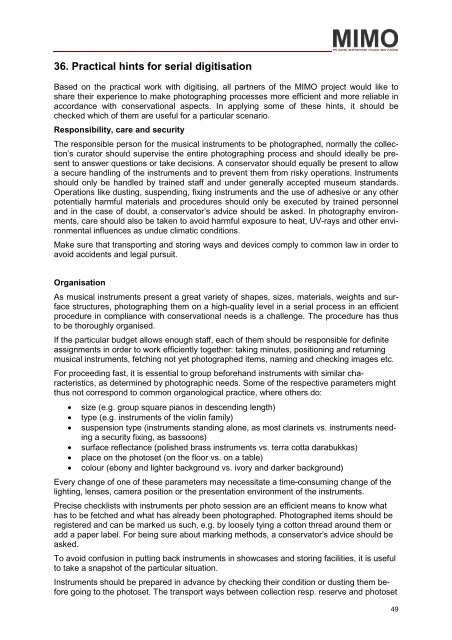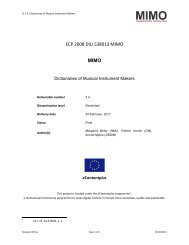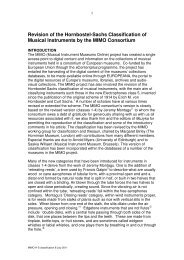MIMO Digitisation Standard
MIMO Digitisation Standard
MIMO Digitisation Standard
- No tags were found...
Create successful ePaper yourself
Turn your PDF publications into a flip-book with our unique Google optimized e-Paper software.
36. Practical hints for serial digitisationBased on the practical work with digitising, all partners of the <strong>MIMO</strong> project would like toshare their experience to make photographing processes more efficient and more reliable inaccordance with conservational aspects. In applying some of these hints, it should bechecked which of them are useful for a particular scenario.Responsibility, care and securityThe responsible person for the musical instruments to be photographed, normally the collection’scurator should supervise the entire photographing process and should ideally be presentto answer questions or take decisions. A conservator should equally be present to allowa secure handling of the instruments and to prevent them from risky operations. Instrumentsshould only be handled by trained staff and under generally accepted museum standards.Operations like dusting, suspending, fixing instruments and the use of adhesive or any otherpotentially harmful materials and procedures should only be executed by trained personneland in the case of doubt, a conservator’s advice should be asked. In photography environments,care should also be taken to avoid harmful exposure to heat, UV-rays and other environmentalinfluences as undue climatic conditions.Make sure that transporting and storing ways and devices comply to common law in order toavoid accidents and legal pursuit.OrganisationAs musical instruments present a great variety of shapes, sizes, materials, weights and surfacestructures, photographing them on a high-quality level in a serial process in an efficientprocedure in compliance with conservational needs is a challenge. The procedure has thusto be thoroughly organised.If the particular budget allows enough staff, each of them should be responsible for definiteassignments in order to work efficiently together: taking minutes, positioning and returningmusical instruments, fetching not yet photographed items, naming and checking images etc.For proceeding fast, it is essential to group beforehand instruments with similar characteristics,as determined by photographic needs. Some of the respective parameters mightthus not correspond to common organological practice, where others do:• size (e.g. group square pianos in descending length)• type (e.g. instruments of the violin family)• suspension type (instruments standing alone, as most clarinets vs. instruments needinga security fixing, as bassoons)• surface reflectance (polished brass instruments vs. terra cotta darabukkas)• place on the photoset (on the floor vs. on a table)• colour (ebony and lighter background vs. ivory and darker background)Every change of one of these parameters may necessitate a time-consuming change of thelighting, lenses, camera position or the presentation environment of the instruments.Precise checklists with instruments per photo session are an efficient means to know whathas to be fetched and what has already been photographed. Photographed items should beregistered and can be marked us such, e.g. by loosely tying a cotton thread around them oradd a paper label. For being sure about marking methods, a conservator’s advice should beasked.To avoid confusion in putting back instruments in showcases and storing facilities, it is usefulto take a snapshot of the particular situation.Instruments should be prepared in advance by checking their condition or dusting them beforegoing to the photoset. The transport ways between collection resp. reserve and photoset49





